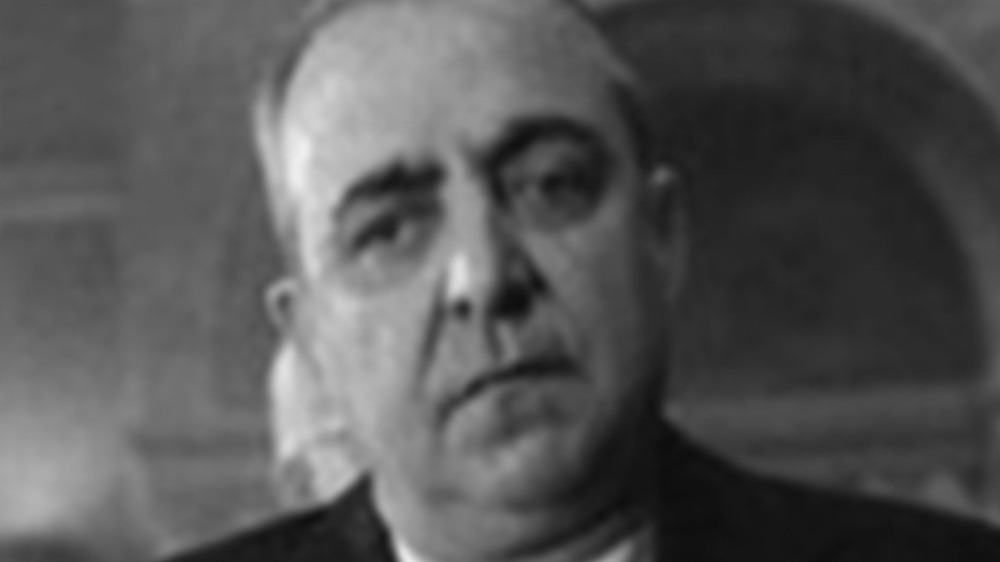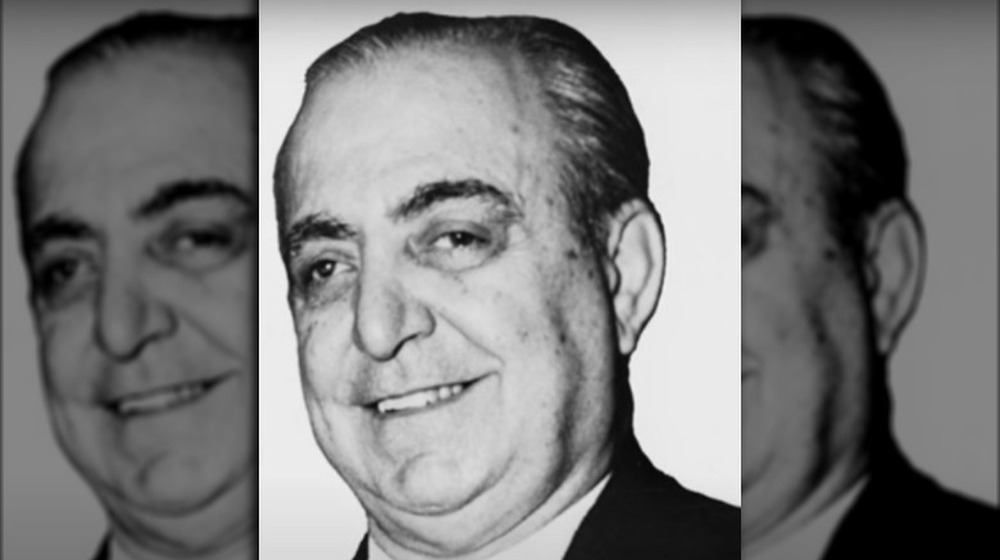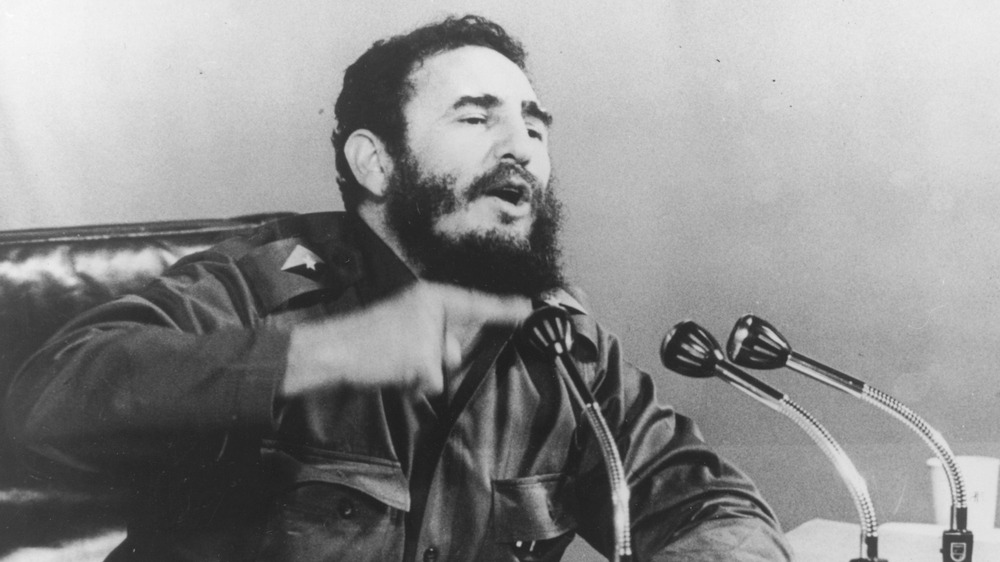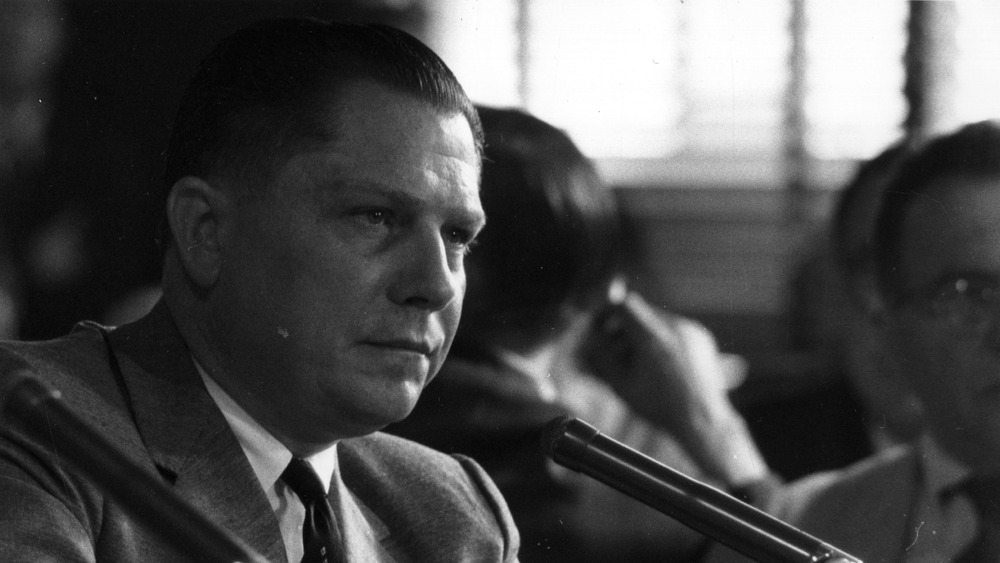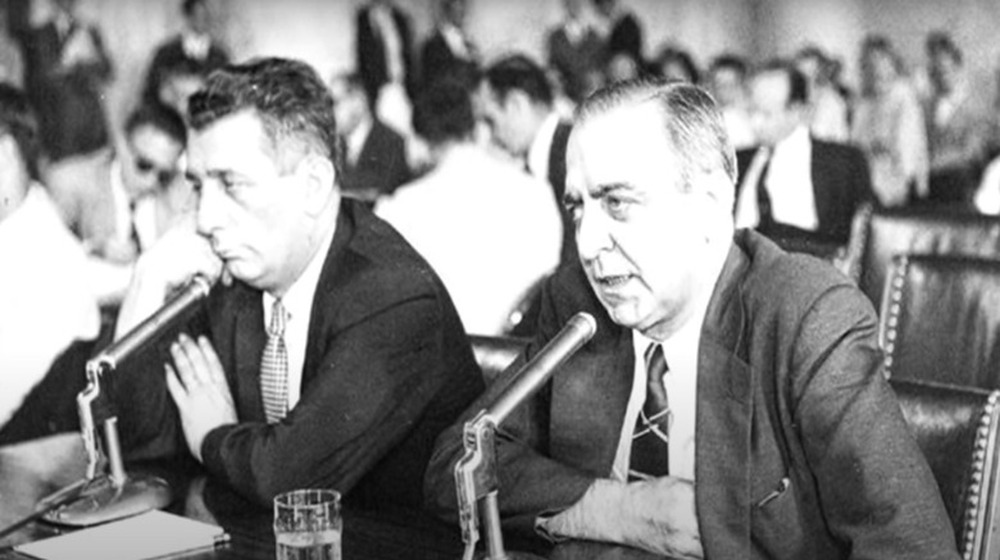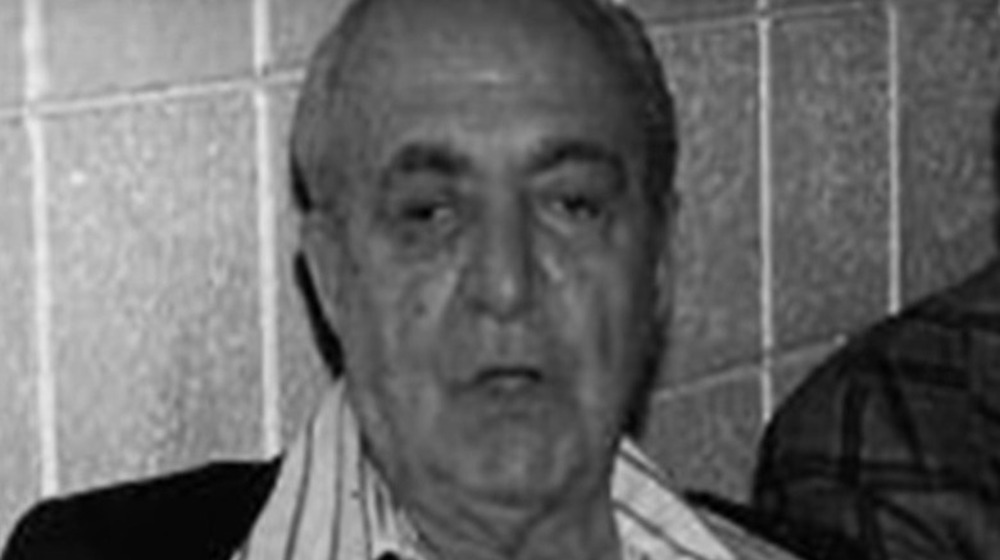The Untold Truth Of Crime Boss Russell Bufalino
We may receive a commission on purchases made from links.
Crime boss Russell Bufalino was a stoic character in the American Mafia in the mid-20th century. In his book The Quiet Don: The Untold Story of Mafia Kingpin Russell Bufalino, Matt Birkbeck called him an "old man with the droopy right eye" who "sure didn't look like anyone important." But looks can be deceiving. Despite his unassuming mien and apparently mild disposition, Bufalino was in reality a ruthless Mafia don who had no mercy for anyone who got on his bad side.
Although as an adult he would try to claim he'd been born in Pennsylvania, Bufalino was actually born in Montedoro, Italy, a town in Sicily, on October 29, 1903. His family immigrated to the United States a couple months later. They settled in Pittston, Pennsylvania, where Bufalino later claimed he'd been born. (According to Justia, before a Senate committee about his immigration status in 1958, Bufalino would plead the fifth when asked about his place of birth.)
According to A Wiser Guy, Bufalino got into crime at a young age. He already had his hand in robbery, extortion, gambling, and debt collection rackets as a teenager, and was arrested for dealing drugs, obstructing justice, and selling stolen goods, among other charges. It was around this time that he met the man who would put him on the path to becoming a Mafioso, the bootlegger Joseph Barbara.
Russell Bufalino organized a meeting of over 100 mobsters
According to Men's Health, Bufalino spent the next few decades working with Barbara, who rose to the top of the Mafia families operating in Pittston, Pennsylvania, and Buffalo, New York in 1940. Barbara then gave Bufalino a promotion, made him an underboss, and sent him to Kingston, Pennsylvania, to oversee their criminal operations there. In 1955, Bufalino met Frank Sheeran, the Teamster and hitman at the center of the Oscar-nominated 2019 film The Irishman, directed by Martin Scorsese.
In 1957, Bufalino organized a summit of more than 100 made men from the United States, Italy, and Cuba. The meeting was held at a ranch owned by Barabara in Apalachin, New York, and was set to be quite the feast. According to The Pittsburg Press, when state troopers and federal agents raided what would go down in mob history as the Apalachin meeting, they confiscated 200 pounds of "choice steaks, veal cutlets, whole hams and pork chops" that were being delivered. The raid confirmed information that undercover agents had been gathering on the Mafia all across the country for the previous two decades. Of the 60 Mafiosi who were arrested that day, around 20 were charged with perjury, Bufalino among them, but prosecutors unfortunately had trouble proving that illegal activity had occurred, and all the charges were eventually dropped. After the death of Barbara in 1959, Bufalino took his place as boss and the family became the Bufalino family.
Russell Bufalino may have had a hand in a CIA plot to assassinate Fidel Castro
Bufalino and other mobsters made quite a bit of money off hotels and casinos in Cuba in the 1950s. In a 2013 interview with The Philadelphia Inquirer, Matt Birkbeck called Havana "the Las Vegas of the 1950s" and "a cash cow" for the Mafia. Bufalino and others were able to make so much money there due to the Mafia's buddy-buddy relationship with Cuban dictator Fulgencio Batista, but that all changed after Fidel Castro led a revolution that toppled Batista's government in 1958. Although Castro had told Bufalino and other mobsters that he wouldn't let the revolution affect their business, he didn't keep his word and expelled the gangsters and their businesses from the island. "Bufalino felt burned by Castro," said Birkbeck.
He may have kept a low-profile, but that didn't mean Bufalino was going to take the slight on the chin. Neither was the U.S. government very happy about what had happened in Cuba, so the CIA is reported to have asked Bufalino for help going after Castro. It is rumored that Bufalino helped the U.S. spy agency plan or carry out (unsuccessfully, obviously) an assassination attempt on Castro just before the disastrous Bay of Pigs Invasion in April 1961. After that failed military operation, the mob was reportedly unhappy with John F. Kennedy, leading to the rumor that the Mafia was behind his assassination in 1963.
Bufalino may have ordered the hit on Jimmy Hoffa
When Bufalino first hired Frank "The Irishman" Sheeran, it was initially as a driver. In Charles Brandt's 2004 book I Heard You Paint Houses, on which the Scorsese movie is based, Sheeran said that he realized the exact nature of Bufalino's business after the Apalachin meeting. "Now I understood why Russell would ask me to drive him to different places and wait for him in the car while he did a little business in somebody's house or in a bar or a restaurant," said Sheeran. He added that despite the mobster's low-key attitude, "Russell Bufalino was as big as Al Capone had been, maybe bigger. I couldn't get over it."
But get over it he soon did, and according to All That Is Interesting, Sheeran was promoted from chauffeur to hitman. His most notable job was "Crazy Joe" Gallo, a rival of Bufalino's. Then, when Teamster Jimmy Hoffa asked Bufalino for help getting rid of his enemies in the Union, it was Sheeran who got the job. However, after Hoffa did a stint in prison for racketeering, Bufalino saw him as a liability, a loose end that was better off tied. Sheeran claimed that Bufalino had him kill the union boss in Detroit and cremate his body in 1975, but since no body was ever found, Hoffa was considered missing. He was declared dead in absentia in 1982.
Bufalino had a problem of trying to kill witnesses
Although pleading the Fifth protected Bufalino from deportation, the law finally caught up with him in the late 1970s. According to The New York Times, he went on trial for extortion in 1977 after threatening to kill a man named Jack Napoli over a $25,000 debt to a New York jeweler. That conviction got him four years in prison, beginning in 1978, of which he served three. He was released in May 1981, but U.S. Senate hearings transcripts state that he was indicted again that very same month on conspiracy charges for attempting to violate Napoli's civil rights (i.e., threatening to kill him). That charge got him another 10 years in prison, which he served in the U.S. Penitentiary in Leavenworth, Kansas. According to his bio on the Mafia Wiki, Bufalino told his sentencing judge, "If you had to deal with an animal like that, Judge, you'd have done the same damn thing."
During his first stint in prison, Bufalino had his consigliere Edward Sciandra run the Bufalino family's business. But by 1982, Sciandra was also behind bars, so during his second stint, Bufalino passed orders to other leaders in the family via his righthand man William D'Elia. Bufalino would only serve seven years of his 10-year sentence.
Russell Bufalino didn't die in prison
Although viewers of The Irishman might be led to believe that Russell Bufalino died in prison, that's not how his life actually ended. According to The Patriot-News, Bufalino did indeed suffer a stroke while serving that last bit of prison time, as Scorsese's film portrays. The movie, however, does not show anything else about Bufalino's life, leading the viewer to assume that the stroke ended it. But Bufalino was actually released in 1989, and died in 1994. He was 90 years old.
It appears as though Bufalino died as he lived. Although he had ordered the violent murders of several people during his time as a Cosa Nostra crime boss, his exit from this world was not the violent way so many of his colleagues and enemies met their own ends. As his entry on Find A Grave states, Bufalino died of natural causes in an assisted living facility. He is buried in the Dension Cemetery in Swoyersville, Pennsylvania, next to his wife, Carrie, who died in 2006.
